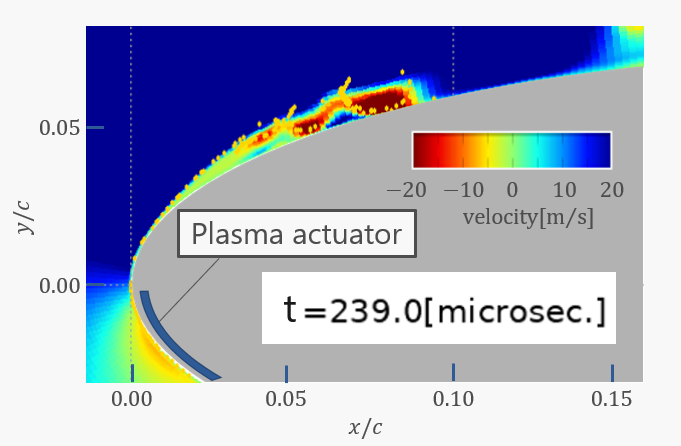Investigation of the effect of slow gas heating on nanosecond-pulse-driven plasma actuators
JAXA Supercomputer System Annual Report February 2022-January 2023
Report Number: R22EACA58
Subject Category: JSS Inter-University Research
- Responsible Representative: Shintaro Sato, Assistant professor, Tohoku University
- Contact Information: Shintaro Sato(satoshin@rhd.mech.tohoku.ac.jp)
- Members: Shintaro Sato, Hibiki Tomie
Abstract
Flow separation control in fluid machinery is an important factor in terms of energy loss. Vortex generators, for example, can suppress separation, but they work only under specific conditions. Active flow control is required to function under a variety of conditions. In recent years, the novel thermal actuator, nanosecond-pulsed-driven plasma actuator, has received considerable attention due to its great potential to control wide range of flows from subsonic to supersonic regimes. The purpose of this study is to investigate the effect of the two-step temperature rise (fast gas heating and slow gas heating) caused by the discharge through numerical simulation.
Reference URL
N/A
Reasons and benefits of using JAXA Supercomputer System
In numerical simulation of nanosecond pulse-driven plasma actuators attached to wings, there is a large difference in the temporal and spatial scales of the discharge and fluid. It is necessary to perform large-domain calculations with fine time steps in order to investigate the effects of the discharge in detail. Therefore, the use of a supercomputer is essential for the calculations conducted in this project.
Achievements of the Year
Numerical simulation on flow control around a airfoil using a nanosecond pulse-driven plasma actuator were performed in this year. A simple model was used for the heating of the plasma actuator, and the amount of energy input was set with reference to experiments. The two-stage heating process is considered by the particle tracking method (Figure 1). The plasma actuator brought the reattachment point closer to the leading edge of the airfoil, but no particular effect of slow gas heating was observed. In the future, we plan to investigate the effect of slow gas heating on the flow after the detachment using three-dimensional numerical simulations.
Publications
– Oral Presentations
Hibiki Tomie, Shintaro Sato, Naofumi Ohnishi, Numerical simulation of flow separation control with nanosecond-pulse-driven plasma actuator, Mechanical Engineering Congress, 2022 Japan, Toyama University, September 2022
Usage of JSS
Computational Information
- Process Parallelization Methods: MPI
- Thread Parallelization Methods: N/A
- Number of Processes: 1 – 88
- Elapsed Time per Case: 48 Hour(s)
JSS3 Resources Used
Fraction of Usage in Total Resources*1(%): 0.06
Details
Please refer to System Configuration of JSS3 for the system configuration and major specifications of JSS3.
| System Name | CPU Resources Used(Core x Hours) | Fraction of Usage*2(%) |
|---|---|---|
| TOKI-SORA | 1766851.03 | 0.08 |
| TOKI-ST | 4.86 | 0.00 |
| TOKI-GP | 0.00 | 0.00 |
| TOKI-XM | 0.00 | 0.00 |
| TOKI-LM | 0.00 | 0.00 |
| TOKI-TST | 0.00 | 0.00 |
| TOKI-TGP | 0.00 | 0.00 |
| TOKI-TLM | 0.00 | 0.00 |
| File System Name | Storage Assigned(GiB) | Fraction of Usage*2(%) |
|---|---|---|
| /home | 110.00 | 0.10 |
| /data and /data2 | 35120.00 | 0.27 |
| /ssd | 150.00 | 0.02 |
| Archiver Name | Storage Used(TiB) | Fraction of Usage*2(%) |
|---|---|---|
| J-SPACE | 3.47 | 0.02 |
*1: Fraction of Usage in Total Resources: Weighted average of three resource types (Computing, File System, and Archiver).
*2: Fraction of Usage:Percentage of usage relative to each resource used in one year.
ISV Software Licenses Used
| ISV Software Licenses Used(Hours) | Fraction of Usage*2(%) | |
|---|---|---|
| ISV Software Licenses(Total) | 0.00 | 0.00 |
*2: Fraction of Usage:Percentage of usage relative to each resource used in one year.
JAXA Supercomputer System Annual Report February 2022-January 2023



